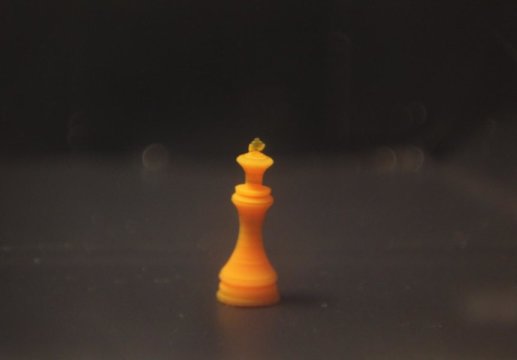Engineers 3-D print shape-shifting smart gel 3-D printing becomes 4-D as objects morph over time and temperatures change
Rutgers University
Summary:
Engineers have invented a '4-D printing' method for a smart gel that could lead to the development of 'living' structures in human organs and tissues, soft robots and targeted drug delivery.

A tiny chess king, 3D-printed with a temperature-responsive hydrogel, in cold water. It contains 73 percent water but remains solid.
Credit: Daehoon Han/Rutgers University-New Brunswick
Rutgers engineers have invented a "4D printing" method for a smart gel that could lead to the development of "living" structures in human organs and tissues, soft robots and targeted drug delivery.
The 4D printing approach here involves printing a 3D object with a hydrogel (water-containing gel) that changes shape over time when temperatures change, said Howon Lee, senior author of a new study and assistant professor in the Department of Mechanical and Aerospace Engineering at Rutgers University-New Brunswick.
The study, published online today in Scientific Reports, demonstrates fast, scalable, high-resolution 3D printing of hydrogels, which remain solid and retain their shape despite containing water. Hydrogels are everywhere in our lives, including in Jell-O, contact lenses, diapers and the human body.
The smart gel could provide structural rigidity in organs such as the lungs, and can contain small molecules like water or drugs to be transported in the body and released. It could also create a new area of soft robotics, and enable new applications in flexible sensors and actuators, biomedical devices and platforms or scaffolds for cells to grow, Lee said.
"The full potential of this smart hydrogel has not been unleashed until now," said Lee, who works in the School of Engineering. "We added another dimension to it, and this is the first time anybody has done it on this scale. They're flexible, shape-morphing materials. I like to call them smart materials."
Engineers at Rutgers-New Brunswick and the New Jersey Institute of Technology worked with a hydrogel that has been used for decades in devices that generate motion and biomedical applications such as scaffolds for cells to grow on. But hydrogel manufacturing has relied heavily on conventional, two-dimensional methods such as molding and lithography.
In their study, the engineers used a lithography-based technique that's fast, inexpensive and can print a wide range of materials into a 3D shape. It involves printing layers of a special resin to build a 3D object. The resin consists of the hydrogel, a chemical that acts as a binder, another chemical that facilitates bonding when light hits it and a dye that controls light penetration.
The engineers learned how to precisely control hydrogel growth and shrinkage. In temperatures below 32 degrees Celsius (about 90 degrees Fahrenheit), the hydrogel absorbs more water and swells in size. When temperatures exceed 32 degrees Celsius, the hydrogel begins to expel water and shrinks. The objects they can create with the hydrogel range from the width of a human hair to several millimeters long. The engineers also found that they can grow one area of a 3D-printed object -- creating and programming motion -- by changing temperatures.
"If you have full control of the shape, then you can program its function," Lee said. "I think that's the power of 3D printing of shape-shifting material. You can apply this principle almost everywhere."
Story Source:
Materials provided by Rutgers University.